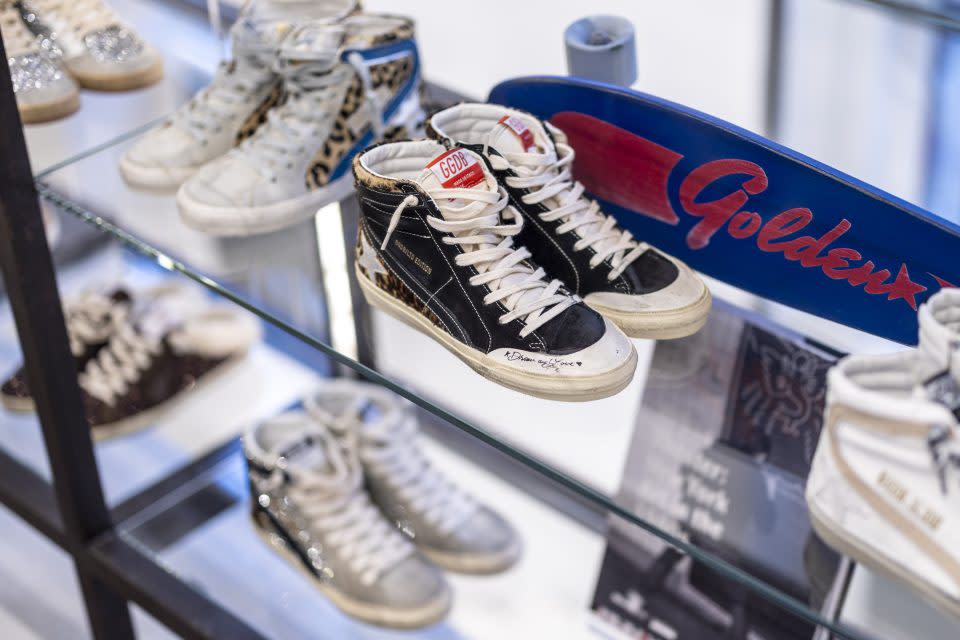Gen Z sneaker brand with $740 ‘dirty’ shoes counts Taylor Swift as a fan—and is eyeing a $3.3 billion valuation
Europe’s stock market nest of growing companies may be awaiting a new hatchling.
Luxury sneaker brand Golden Goose is preparing for an initial public listing in Milan as early as this week, Bloomberg reported. Stock will reportedly begin trading in July. The company, owned by private-equity firm Permira, has gotten favorable feedback from potential investors, who expect the company to be valued at about $3.3 billion, the equivalent of 11 times its estimated 2024 earnings, Bloomberg calculated.
Golden Goose did not respond to Fortune’s request for comment.
The shoe brand had blowout 2023 earnings, reporting $637 million in revenue, an over 17% bump from 2022’s $543 million. Opening up 21 stores last year to total 191 brick-and-mortar locations, Golden Goose is eyeing an even more ambitious 2024, tapping former Gucci CEO Marco Bizzarri to join its board in April.
Golden Goose’s breakaway success is in stark contrast with the persistent lag of luxury goods. Paris-based LVMH and Gucci-owner Kering saw first-quarter sales slow, as spending-shy consumers stopped buying pricing goods, or chose to otherwise spend money on luxury experiences such as cruises.
The brand, favored by celebrities like Taylor Swift, Reese Witherspoon, and Michael Phelps, is easily recognized by its yellowed, weathered soles and knotted laces, somewhat deceiving of its $740 price tag. It’s a tip-of-the-hat to the designer jeans of years past, with substantial tears, distressed denim, and exorbitant price tags.

But Golden Goose, despite its star-studded following, has also struck a chord with Gen Z, whose obsession with shabby chic and quiet luxury has the generation clamoring for the shoe. About 80% of Golden Goose’s consumer base is Gen Z or millennial, according to CEO Silvio Campara.
"They come dirty, so I don't care when I get them dirty," influencer Syndey Schiffer said in a TikTok.
From goose egg to unicorn
Though founded in Venice, Italy in 2000, Golden Goose launched its brand-defining sneakers in 2007, just in time to ride the wave of the streetwear boom that saw stars like A$AP Rocky and Kanye West partner with luxury brands, leading the likes of Valentino and Givenchy to churn out expensive white sneakers.
“In 2007, there wasn’t a fashion sneaker like Golden Goose,” Marina Larroude, the fashion director at Barneys New York told The Cut in 2017. “There were the sportswear brands and then the high-end fashion houses who produced very precious sneaker styles, but there was no real in-between. Golden Goose filled that void by providing a fashion sneaker that looks polished and cool, but was not too precious.”
Golden Goose’s signature look may be synonymous with modern streetwear, but it's drawn controversy for “glorifying poverty,” particularly after the brand launched a $585 sneaker with what appears to be a piece of duct tape strapped to its toe and heel.
Don’t let the shoes’ battered look fool you: The company prizes its artisanship above all else. In 2022, Golden Goose’s flagship store in Milan expanded to offer in-house cobbling and repairs, a $100 add-on to the already pricey sneaker. It employs a cadre of 20- and 30-something-year-old store employees to embellish products with rhinestones and patches.
“Artisans are able to produce uniqueness with their hands,” Campara told the New York Times. “And artisanship creates affection.”
But despite the brand’s efforts to retain its artisan edge, Campara has no plans to hike shoe costs in order to drive up the bottom line, saying its reputation will carry the brand to new heights.
“It’s not by being expensive that you are luxury, it’s by being meaningful and relevant,” Campara told Financial Times. “Luxury positioning would be a point of weakness in terms of pricing. But when it comes to experience, luxury positioning is a point of strength. Thank God we are in the second position.”
This story was originally featured on Fortune.com

 Yahoo Finance
Yahoo Finance 